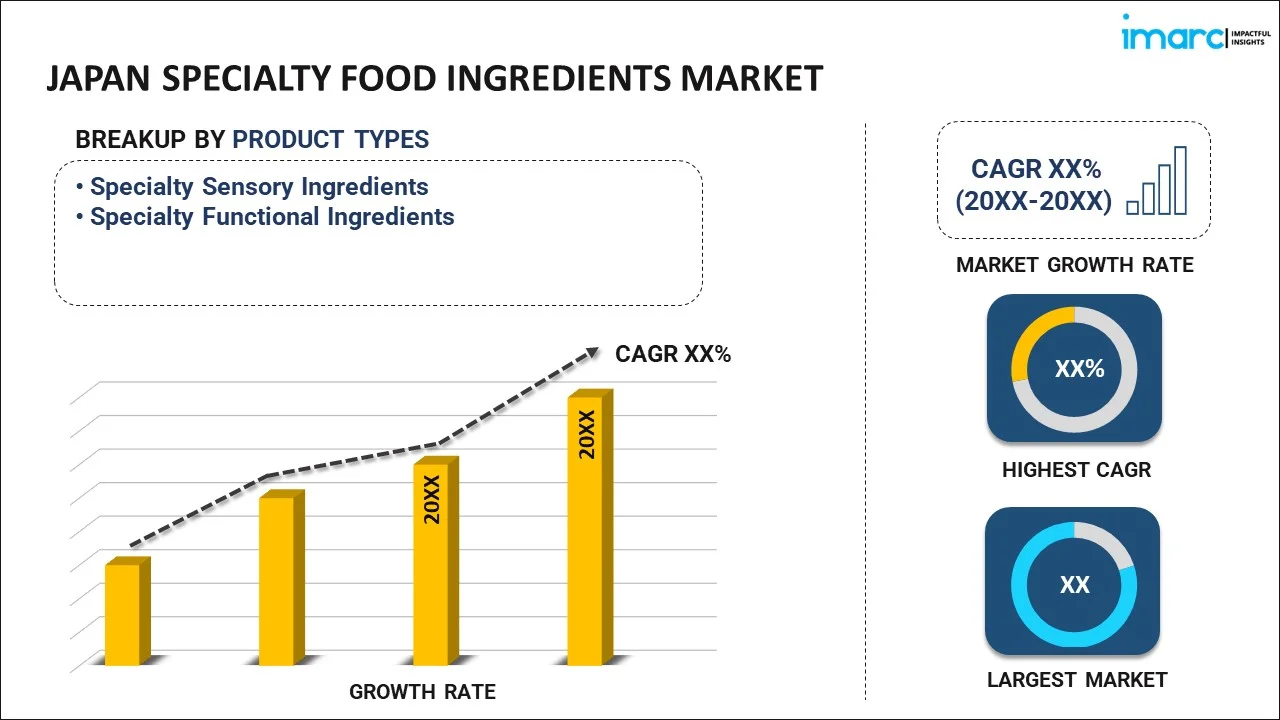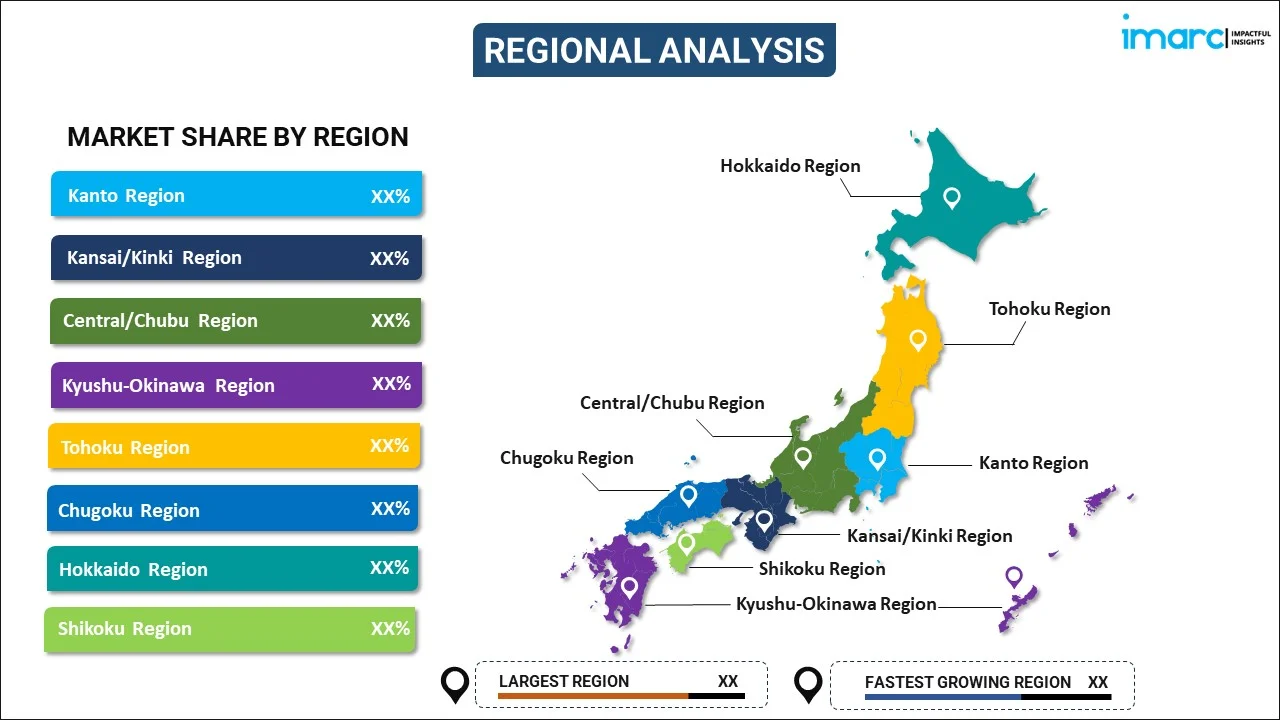
Japan Specialty Food Ingredients Market Report by Product Type (Specialty Sensory Ingredients, Specialty Functional Ingredients), Source (Natural, Synthetic), Application (Beverages, Bakery and Confectionery, Dairy Products, Processed Foods, Meat Products, Savory and Sweet Snacks, and Others), Distribution Channel (Distributors, Manufacturers), and Region 2025-2033
Market Overview:
Japan specialty food ingredients market size reached USD 3.7 Billion in 2024. Looking forward, IMARC Group expects the market to reach USD 5.8 Billion by 2033, exhibiting a growth rate (CAGR) of 4.85% during 2025-2033. The increasing prevalence of dietary restrictions, including gluten-free, dairy-free, and nut-free diets, which has enhanced the demand for specialty ingredients that cater to these needs, is driving the market.
|
Report Attribute
|
Key Statistics
|
|---|---|
|
Base Year
|
2024 |
|
Forecast Years
|
2025-2033 |
|
Historical Years
|
2019-2024
|
| Market Size in 2024 | USD 3.7 Billion |
| Market Forecast in 2033 | USD 5.8 Billion |
| Market Growth Rate (2025-2033) | 4.85% |
Specialty food ingredients refer to unique and high-quality components that are used in the food and beverage industry to enhance flavor, texture, appearance, and overall product quality. These ingredients are often selected for their specific functional properties and are not typically found in everyday cooking or processing. They play a crucial role in creating distinctive and innovative food products that cater to consumer preferences for diverse tastes and dietary requirements. Specialty food ingredients encompass a wide range of substances, including natural extracts, spices, herbs, exotic fruits, specialty flours, sweeteners, and various additives. These ingredients can be used to add complexity to flavors, improve food preservation, provide color, increase nutritional value, or address specific dietary needs such as gluten-free or low-sugar options. They are essential for creating gourmet, artisanal, and health-focused foods, as well as for meeting evolving consumer demands for unique culinary experiences. Specialty food ingredients are often the secret behind the exceptional taste and quality of premium and niche food products.
Japan Specialty Food Ingredients Market Trends:
The specialty food ingredients market in Japan is experiencing robust growth, primarily due to several key drivers. Firstly, changing consumer preferences has played a pivotal role in propelling this market forward. Consumers are increasingly seeking unique and exotic flavors, driving the demand for specialty ingredients that can provide distinct tastes and textures. Moreover, the growing awareness of health and wellness has led to a surge in demand for natural and functional ingredients, such as superfoods, probiotics, and plant-based alternatives. This health-conscious trend has driven food manufacturers to incorporate these specialty ingredients into their products. Additionally, the rise of numerous cuisines and fusion foods has further fueled the demand for unique and authentic ingredients. Lastly, the ongoing trend of premiumization and gourmet food experiences, which has led to an increased willingness among consumers to pay a premium for high-quality specialty ingredients, is expected to drive the specialty food ingredients market in Japan during the forecast period.
Japan Specialty Food Ingredients Market Segmentation: -
IMARC Group provides an analysis of the key trends in each segment of the market, along with forecasts at the country level for 2025-2033. Our report has categorized the market based on product type, source, application, and distribution channel.
Product Type Insights:

- Specialty Sensory Ingredients
- Enzymes
- Emulsifiers
- Flavors
- Colorants
- Others
- Specialty Functional Ingredients
- Vitamins
- Minerals
- Antioxidants
- Preservatives
- Others
The report has provided a detailed breakup and analysis of the market based on the product type. This includes specialty sensory ingredients (enzymes, emulsifiers, flavors, colorants, and others) and specialty functional ingredients (vitamins, minerals, antioxidants, preservatives, and others).
Source Insights:
- Natural
- Synthetic
A detailed breakup and analysis of the market based on the source have also been provided in the report. This includes natural and synthetic.
Application Insights:
- Beverages
- Bakery and Confectionery
- Dairy Products
- Processed Foods
- Meat Products
- Savory and Sweet Snacks
- Others
The report has provided a detailed breakup and analysis of the market based on the application. This includes beverages, bakery and confectionery, dairy products, processed foods, meat products, savory and sweet snacks, and others.
Distribution Channel Insights:
- Distributors
- Manufacturers
A detailed breakup and analysis of the market based on the distribution channel have also been provided in the report. This includes distributors and manufacturers.
Regional Insights:

- Kanto Region
- Kansai/Kinki Region
- Central/ Chubu Region
- Kyushu-Okinawa Region
- Tohoku Region
- Chugoku Region
- Hokkaido Region
- Shikoku Region
The report has also provided a comprehensive analysis of all the major regional markets, which include Kanto Region, Kansai/Kinki Region, Central/ Chubu Region, Kyushu-Okinawa Region, Tohoku Region, Chugoku Region, Hokkaido Region, and Shikoku Region.
Competitive Landscape:
The market research report has also provided a comprehensive analysis of the competitive landscape in the market. Competitive analysis such as market structure, key player positioning, top winning strategies, competitive dashboard, and company evaluation quadrant has been covered in the report. Also, detailed profiles of all major companies have been provided.
Japan Specialty Food Ingredients Market Report Coverage:
| Report Features | Details |
|---|---|
| Base Year of the Analysis | 2024 |
| Historical Period | 2019-2024 |
| Forecast Period | 2025-2033 |
| Units | Billion USD |
| Scope of the Report | Exploration of Historical Trends and Market Outlook, Industry Catalysts and Challenges, Segment-Wise Historical and Future Market Assessment:
|
| Product Types Covered |
|
| Sources Covered | Natural, Synthetic |
| Applications Covered | Beverages, Bakery and Confectionery, Dairy Products, Processed Foods, Meat Products, Savory and Sweet Snacks, Others |
| Distribution Channels Covered | Distributors, Manufacturers |
| Regions Covered | Kanto Region, Kansai/Kinki Region, Central/ Chubu Region, Kyushu-Okinawa Region, Tohoku Region, Chugoku Region, Hokkaido Region, Shikoku Region |
| Customization Scope | 10% Free Customization |
| Post-Sale Analyst Support | 10-12 Weeks |
| Delivery Format | PDF and Excel through Email (We can also provide the editable version of the report in PPT/Word format on special request) |
Key Questions Answered in This Report:
- How has the Japan specialty food ingredients market performed so far and how will it perform in the coming years?
- What has been the impact of COVID-19 on the Japan specialty food ingredients market?
- What is the breakup of the Japan specialty food ingredients market on the basis of product type?
- What is the breakup of the Japan specialty food ingredients market on the basis of source?
- What is the breakup of the Japan specialty food ingredients market on the basis of application?
- What is the breakup of the Japan specialty food ingredients market on the basis of distribution channel?
- What are the various stages in the value chain of the Japan specialty food ingredients market?
- What are the key driving factors and challenges in the Japan specialty food ingredients?
- What is the structure of the Japan specialty food ingredients market and who are the key players?
- What is the degree of competition in the Japan specialty food ingredients market?
Key Benefits for Stakeholders:
- IMARC’s industry report offers a comprehensive quantitative analysis of various market segments, historical and current market trends, market forecasts, and dynamics of the Japan specialty food ingredients market from 2019-2033.
- The research report provides the latest information on the market drivers, challenges, and opportunities in the Japan specialty food ingredients market.
- Porter's five forces analysis assist stakeholders in assessing the impact of new entrants, competitive rivalry, supplier power, buyer power, and the threat of substitution. It helps stakeholders to analyze the level of competition within the Japan specialty food ingredients industry and its attractiveness.
- Competitive landscape allows stakeholders to understand their competitive environment and provides an insight into the current positions of key players in the market.
Need more help?
- Speak to our experienced analysts for insights on the current market scenarios.
- Include additional segments and countries to customize the report as per your requirement.
- Gain an unparalleled competitive advantage in your domain by understanding how to utilize the report and positively impacting your operations and revenue.
- For further assistance, please connect with our analysts.
 Inquire Before Buying
Inquire Before Buying
 Speak to an Analyst
Speak to an Analyst
 Request Brochure
Request Brochure
 Request Customization
Request Customization




.webp)




.webp)












